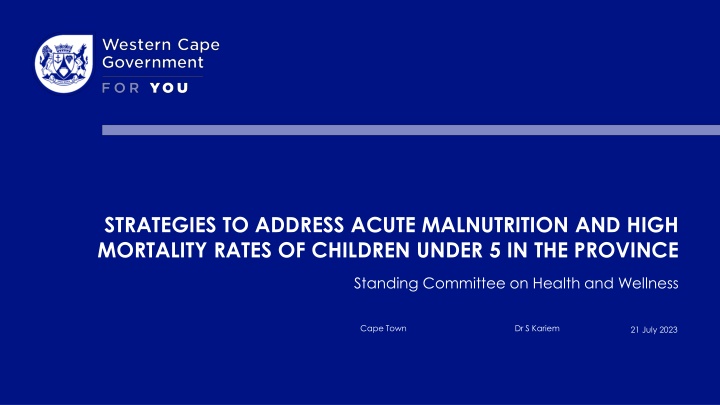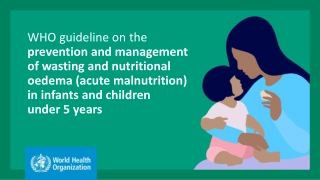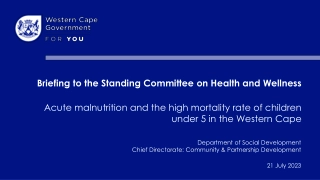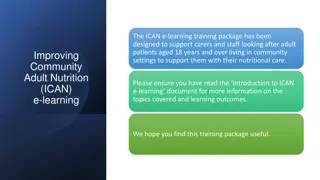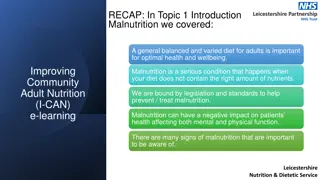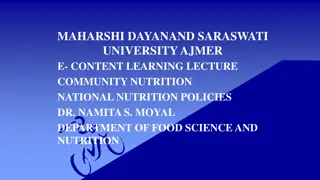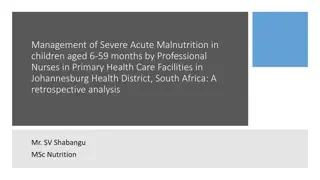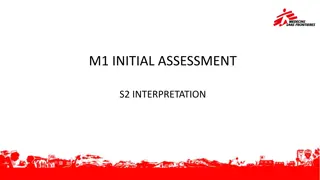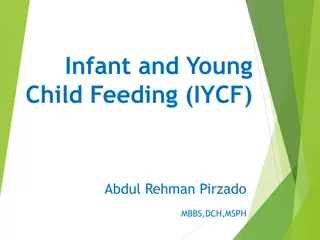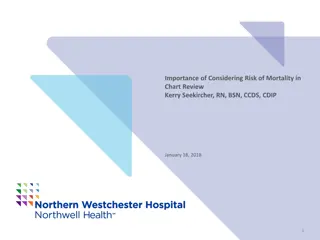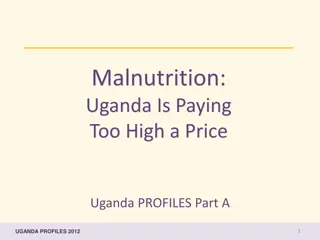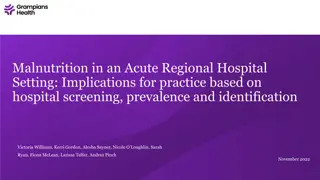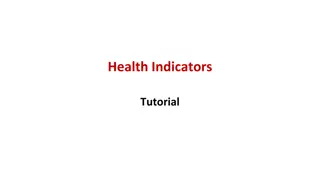Strategies to Address Acute Malnutrition and High Mortality Rates in Children Under 5
Malnutrition in children under 5, specifically acute malnutrition, is a pressing issue in the Western Cape. This presentation outlines the current strategies, multisector engagement, causes, and impacts of acute malnutrition. It delves into the classifications of malnutrition, including severe and moderate cases, and discusses the factors contributing to malnutrition in children. The importance of multi-stakeholder engagements and the need for ongoing efforts to combat acute malnutrition are highlighted in this comprehensive overview.
Download Presentation

Please find below an Image/Link to download the presentation.
The content on the website is provided AS IS for your information and personal use only. It may not be sold, licensed, or shared on other websites without obtaining consent from the author.If you encounter any issues during the download, it is possible that the publisher has removed the file from their server.
You are allowed to download the files provided on this website for personal or commercial use, subject to the condition that they are used lawfully. All files are the property of their respective owners.
The content on the website is provided AS IS for your information and personal use only. It may not be sold, licensed, or shared on other websites without obtaining consent from the author.
E N D
Presentation Transcript
STRATEGIES TO ADDRESS ACUTE MALNUTRITION AND HIGH MORTALITY RATES OF CHILDREN UNDER 5 IN THE PROVINCE Standing Committee on Health and Wellness Cape Town Dr S Kariem 21 July 2023
Outline of presentation Current Strategies Setting the Context Multisector Engagement What is Acute Malnutrition, What Causes it, and what does it look like in the Western Cape What is currently being done by the Western Cape to reduce the impact of Acute Malnutrition Analysis of the Multi-stakeholder engagements currently being implemented
Introduction Malnutrition, as defined by WHO, encompasses nutrient deficiencies or excesses, imbalances, and impaired utilization, including both overnutrition (related to overweight/obesity) and undernutrition (acute/chronic malnutrition, micronutrient deficiencies). Acute Malnutrition is a result of a sudden reduction in food intake or the poor quality of food, often associated with pathological causes. 2 main categorizations: 1. Severe Acute Malnutrition is defined and measured by: Mid-Upper Arm Circumference (MUAC) of less than 11.5cm in children aged 6 60 months (circumference of child s left upper arm). Weight-for-Height (WH) or Weight-for-Length (WL) below -3 standard deviations (SD) or z-score <-3 The presence of bilateral pitting pedal oedema (nutritional oedema). 2. Moderate Acute Malnutrition is defined as: a WH/L between -3 and -2 SD below the median of the WHO child growth standards/ z-score between -3 and -2; or MUAC between 11.5cm and 12.5. The child doesn t have any oedema and has a good appetite. Chronic malnutrition results from insufficient intake or absorption of essential nutrients over a protracted period. - Lenters L, Wazny K, Bhutta ZA. Management of Severe and Moderate Acute Malnutrition in Children. In: Black RE, Laxminarayan R, Temmerman M, et al., editors. Reproductive, Maternal, Newborn, and Child Health: Disease Control Priorities, Third Edition (Volume 2). Washington (DC): The International Bank for Reconstruction and Development / The World Bank; 2016 Apr 5. Chapter 11. Available from: https://www.ncbi.nlm.nih.gov/books/NBK361900/ doi: 10.1596/978-1-4648-0348-2_ch11
Classification of Malnutrition deficiencies or excesses in nutrient intake, imbalance of essential nutrients or impaired nutrient utilization Malnutrition sudden reduction in food intake or the poor quality of food Can Become Acute Chronic (stunting) Overweight/Obesity Moderate Severe Severe starvation
Causes of Malnutrition Malnutrition is multifaceted and can be caused by numerous factors throughout a child s life. Some of which Include: Targeted directly by the First 1000 days initiative Decrease in stunting rates seen in 2023 baseline survey Food insecurity: Limited access to sufficient, nutritious food due to poverty, unemployment, and unequal distribution of resources Inadequate breastfeeding practices: Suboptimal breastfeeding, such as early introduction of formula or inadequate exclusive breastfeeding Poor dietary diversity: Limited availability and affordability of diverse and nutritious foods, coupled with unhealthy eating patterns Inadequate maternal and child healthcare: Insufficient access to quality healthcare services, including prenatal and postnatal care Water and sanitation challenges: Lack of clean water, sanitation facilities, and hygiene practices Social and economic factors: Socioeconomic disparities, unemployment, limited education, and social HIV/AIDS: The prevalence of HIV/AIDS in the Western Cape can affect nutritional status "CD Volume 7: Appendix 1: Malnutrition." Western Cape Government, 2007, www.westerncape.gov.za/text/2007/6/cd_volume_7_appendix_1
Stunting Baseline Conducted to assess and establish the prevalence and severity of stunting among children in the province Emphasizing Exclusive Breastfeeding: Only 18% of all children were exclusively breastfed Importance of dietary diversity Children are not consuming necessary nutrients but are eating high sugar/fat foods Aimed to gather data on the current status of stunting, identify high-risk populations, and inform targeted interventions and policies to address the issue 2023 stunting survey showed overall improvement: 27.4% in 2016 to 17.55% in 2023 Key Considerations: Improving infrastructure: Those without proper access to clean water had an increased risk of stunting Preventing risky behaviours like smoking during pregnancy Successful predictor of stunting It also found that 19.7% of children under the age of two are stunted. Additional interventions to further prevent and control malnutrition in children under-5-year-old children will be implemented following a whole of society approach Goal now to engage different stakeholders who will best be able to achieve recommendations created from baseline survey
Stunting predictors 6 months-<2 years 2 years-<5 years
Surge Season: U5 LRTI Episodes & Admissions The rate of u5 LRTI admitted episodes peaked earlier compared to 2017-2021, and only crossed the median intensity threshold. u5 LRTI admissions peaked in March this year with 2050 admissions but decreased in April to June relative to 2022. Data: LRTI episodes here are all encounters where an ICD10 code matched the PHDC mapping for LRTI, on any diagnostic field, from all electronic sources. All encounters within a 21 days window from first evidence date are counted as a single episode per pmi. Only episodes where an admission occurred within 21 days are used to calculate the provincial rate per 100 000. Data: LRTI admissions here are all admissions where an ICD10 code matched the PHDC mapping for ICD10 codes for LRTI, on any diagnostic field, at any date from admission to discharge.
Surge Season: Diarrhoea Admissions Diarrhoea admissions in 2023 remain lower compared to 2022. Data: Diarrhoea admissions here are all admissions where an ICD10 code matched the PHDC mapping for ICD10 codes for diarrhoea, on any diagnostic field, at any date from admission to discharge.
Surge Season: Admissions with Malnutrition Admissions with SAM and MAM peaked in Quarter 1, 2022. Admissions in 2023 are still high relative to 2019- 2021. Data: Admissions with SAM and MAM are derived here from the Nutritional Status check box in eCCR. Where not available, the PHDC mapping for ICD10 codes for SAM only are used at any stage of admission on any diagnostic field.
Severe Acute Malnutrition The SAM and MAM are monitored with the following indicators: - Severe Acute Malnutrition in child under 5 years, (incidence, of # of new cases of a condition during a certain time) Separations in Severe Acute Malnutrition measured by death rate, or # of deaths in a population during a certain time, discharges, or transfers - - Moderate Acute Malnutrition in child under 5 years, new indicator (incidence)
SAM Incidence WC SAM Incidence <5 UW <5 Q1: Apr- Jun Q2: Jul- Sep Q3: Oct- Dec Q4: Jan- Mar Total Quarter 1 April-June 2023 Districts 2022/2023 Poverty Index Cape Town 1.01 0.97 0.78 1.10 1.93 16.02 0.35 Cape Winelands 2.01 1.93 2.48 2.27 4.34 19.16 0.67 Central Karoo 1.48 0.00 3.94 6.41 5.92 15.35 0.00 Eden 2.28 1.58 2.03 1.84 3.86 19.31 0.51 Overberg 1.77 0.25 1.64 1.64 2.66 15.33 0.51 West Coast Western Cape Province 0.57 1.54 0.81 1.14 2.03 16.88 0.73 17.01 1.28 1.16 1.22 1.43 2.54 0.45
SAM Incidence MHS SAM Incidence Severe Acute Malnutrition incidence Target: <2.2% Quarter 1 April- June 2023 Quarter 1 2022/2023 Quarter 2 2022/2023 Quarter 3 2022/2023 Quarter 4 2022/2023 Total Districts Sub districts (2022/2023) Cape Town CT Eastern 0.00 1.32 1.95 1.32 2.52 0.00 CT Khayelitsha 2.25 2.25 0.22 2.02 3.37 1.80 CT Klipfontein 0.91 0.73 0.73 1.82 2.10 0.00 CT Mitch Plain 1.85 1.41 0.67 1.33 2.63 0.33 CT Northern 0.39 0.78 0.24 0.78 1.10 0.27 CT Southern 0.62 0.42 0.21 0.83 1.04 0.36 CT Tygerberg 0.48 0.24 0.12 0.00 0.42 0.00 CT Western Cape Town Total 1.52 0.94 1.41 1.23 2.55 0.27 1.01 0.97 0.78 1.10 1.93 0.35
SURVIVE THRIVE AND TRANSFORM Survive = end preventable deaths Thrive = ensure health and well being Transform = expand enabling environments Integrated Nutrition Programme 2019
Framework of action to achieve optimum fetal and child nutrition and development Marie T. Ruel 1 and Harold Alderman 1 and the Maternal and Child Nutrition Study Group 1 International Food Policy Research Institute (IFPRI)
Nurturing care Framework The Nurturing Care Framework (WHO) supports children's well- being, caregiver support, and health potential. supported by the First 1000 Days Initiative and RtHB, promoting caregiver-healthcare collaboration for child development. emphasizes childhood nutrition's importance for long-term outcomes, monitored by First 1000 Days Initiative and RtHB.
Facts about 1st 1000 days Malnutrition during the first thousand days, including the prenatal period, significantly raises the likelihood of infant mortality and can lead to long-lasting cognitive, physical, and chronic health issues that persist throughout life Parent/Caregiver/Family Support packages 1. Communicati on 2. The right nutrition during the first 1,000 days has a profound impact on a child's cognitive development and learning abilities, setting the foundation for their future well-being. Ensuring access to proper nutrition and care during this critical window is vital. 7. Risk Capturing Learnings Assessment, Referral and Support 4. Road to Health Booklet and Side by Side Campaign 3. Exclusive infant feeding, recommended for the first six months of life, plays a pivotal role in promoting healthy development. 6. Training and Support of staff Parent Resources aligned to Touch Points 5. Home and community family relationship support In order to ensure that Parents are aware of the connection between factors like childhood nutrition and long-life outcomes, Parent/Caregiver/Family Support packages are encouraged 20 Breastfeeding Webinar 6 August 2021, Acknowledgement Dr HD Goeiman
Evolution of the Road to Health Booklet RtHB 2018 2011 2002 Growth standards Z scores replacing centiles Weight for Length Weight for Age PRESCHOOL CARDS 1994 Immunization schedule Updated Deworming New 1972 PMTCT information Infant feeding information TB status Record contact and disease Integrated Nutrition Programme 2019
Every child needs to survive, thrive and transform The revised Road to Health Booklet is a tool that should be used as basis to improve child health in South Africa. The RtHB s focuses on what the child needs rather than what the departments must offer . It is user-friendly It incorporate critical development aspects as well as linkage to care. Patient Health tool 22
THE 5 THEMES OF THE ROAD TO HEALTH BOOK ARE WHAT CHILDREN NEED TO DEVELOP NUTRITION Good nutrition is important for you and your child to grow and be healthy. It starts with breastfeeding. Growth monitoring 0 to 5 year LOVE Your child learns from looking at you when you hold them close to you and love, play and talk to them. PROTECTION Your child can be protected from disease and injury by getting immunised and by playing in safe places. HEALTHCARE Your child needs help from you or a health worker when they are sick or injured. EXTRA CARE Your child may need special care or support and knowing what to do and where to go will help both of you.
Information on growth monitoring (Page 8 -10) This figure on page 8 shows a health worker doing MUAC screening. MUAC screening should be done at every visit from 6 months to 5 years. MUAC is used to identify moderate or severe acute malnutrition (MAM or SAM). This chart is used to record the MUAC and classify 24
Growth Charts (Page 11 20) On page 11in the RTHB are 3 sets of charts for each gender. It is important for health workers to plot on the correct charts. The booklet has both girls and boys charts. Height for Age can be plotted every six months . The Weight for Age Chart is the most important chart to be plotted at every visit in the 1st years. Weight for height shows body weight relative to length/ height At year 2 the child growth can be monitored every second month if child is growing well. 25
Growth Monitoring and Promotion (GMP) GMP is widely regarded as a key essential element of child- survival and Primary Health Care (PHC) and can positively impact the growth and development of children. Growth monitoring of young children is recognized as A tool to prevent malnutrition an effective means of detecting growth faltering early providing a critical opportunity for preventive or curative actions a powerful tool for increasing community awareness
Growth Monitoring and Promotion across the Life Course Preconception & Pregnancy Infancy & early years (0-5 years) Childhood & Adolescents Working age & Adults (16-64 years) Older people Circular on route
MBFI strategy in the Western Cape Circular H62/2023 The Western Cape Government Department of Health and Wellness (WCGH&W) has institutionalized the implementation of the Mother-Baby Friendly Initiative (MBFI) strategy since 2009. Successful implementation of the Ten steps to successful breastfeeding has shown to improve the rates of exclusive breastfeeding and prolong breastfeeding duration beyond discharge from a birthing unit. It implements: standards of care to support optimal infant feeding early initiation of breastfeeding within 1 hour of birth; skin-to-skin contact exclusive breastfeeding for the first 6 months of life; and introduction of nutritionally-adequate and safe complementary (solid) foods at 6 months together with continued breastfeeding up to 2 years of age or beyond.
Integrated management of Acute Malnutrition (IMAM) Policy Circular H76/2021 The Integrated Management of Acute Malnutrition (IMAM) links routine health services with Community Based Services to optimize coverage, assessment, and treatment of acute malnutrition. Key interventions to prevent the development of acute malnutrition include appropriate breastfeeding and complementary feeding practices. It must be noted that disease prevention strategies are important in breaking the infection- malnutrition cycle, particularly related to diarrhoea and repeated respiratory infections. The key determinants in the treatment of acute malnutrition however encompasses more than feeding practices and includes factors which facilitates identification, follow up and monitoring and evaluation of implementation.
Nutritional Therapeutic Programme Circular H27/2023 The Nutrition Therapeutic Programme (NTP) is a nutrition specific intervention implemented to address undernutrition in various categories of patients. It forms part of the Health Facility Based Nutrition Programme (HFBNP), which is based on an integrated, comprehensive primary health care model focusing on nutritional health. The NTP was designed to provide nutritional support using specialized products to at risk clients and those in the rehabilitation phase to improve their treatment outcomes and wellbeing. Some of the objectives of the NTP is to provide nutritional support to nutritionally at-risk clients, which include Moderately Acute Malnutrition & Severely Acute Malnutrition child in the rehabilitation phase and growth faltering infants and young children.
COPC COPC is a community-based healthcare approach that focuses on addressing community needs, promoting community participation, and improving health outcomes. Strategies outlined by COPC actively assist in preventing Acute Malnutrition by encouraging individual ownership of health Better communication between healthcare providers and communities promotes educative opportunities for future mothers COPC promotes frequent community-based screenings and assessments helps identify individuals experiencing deficiencies and who are at a high risk of malnutrition
Intersectoral engagement, innovation and transversal projects
Social Relief of Distress & Community Kitchen Circular H156/2017 Referral System Pathway Social Relief of Distress (SRD) programs like the Zero Hunger Campaign and Normal Social Relief of distress are programs that aim to reduce food insecurity in children and adults. Referral by health workers is required for eligible children and adults to access SRD programs that assist with providing food The Zero Hunger Campaign directly aligns with reducing acute malnutrition as it targets high risk children aged 0-5 "Social Relief of Distress Grant." Western Cape Government, www.westerncape.gov.za/service/social-relief- distress-grant.
Western Cape Education Department Early Childhood Development Centres ECD centres serve as an effective platform to deliver child health services to underserved children. Outreach services at ECD centres include malnutrition identification (GMP), provision of Vitamin A and deworming, and catch-up immunization Food services in care facilities have undergone significant changes to meet national and international standards. The WCGHW and partners have developed an operational manual which aims to: Establish minimum standards and requirements for community-level food services Ensure standardized nutrition for children in care facilities Provide guidance to food handlers on safety, affordability, and appetizing meals.
DOTP Family Strengthening programme All programmes aims at strengthening the relationship between a primary caregiver and a child. Purpose to reduce family and community violence. Can be referred to as parenting programmes. Family support through family strengthening programmes is a primary violence prevention tool that can potentially be accessed by any family. Positive parenting is warm, consistent parenting where parents have good relationships with their children, use non-violent forms of discipline and exercise supervision over their children as appropriate to their developmental stage . They aim to nurture and strengthen family relationships.
City of Cape Town Reading Campaign 1000 stories before school - 2021 Tips for challenges Tips for parents Lula byes Tracking your reading journey
Acknowledgements DG Murray Trust Hilary Goeiman Nicolette Henney Millicent February Isabella Moscoe Kelly Fortune
